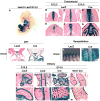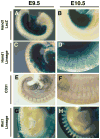Analysis of the Hand1 cell lineage reveals novel contributions to cardiovascular, neural crest, extra-embryonic, and lateral mesoderm derivatives
- PMID: 20882677
- PMCID: PMC2965316
- DOI: 10.1002/dvdy.22428
Analysis of the Hand1 cell lineage reveals novel contributions to cardiovascular, neural crest, extra-embryonic, and lateral mesoderm derivatives
Abstract
The basic Helix-Loop-Helix (bHLH) transcription factors Hand1 and Hand2 play critical roles in the development of multiple organ systems during embryogenesis. The dynamic expression patterns of these two factors within developing tissues obfuscate their respective unique and redundant organogenic functions. To define cell lineages potentially dependent upon Hand gene expression, we generated a mutant allele in which the coding region of Hand1 is replaced by Cre recombinase. Subsequent Cre-mediated activation of β-galactosidase or eYFP reporter alleles enabled lineage trace analyses that clearly define the fate of Hand1-expressing cells. Hand1-driven Cre marks specific lineages within the extra embryonic tissues, placenta, sympathetic nervous system, limbs, jaw, and several cell types within the cardiovascular system. Comparisons between Hand1 expression and Hand1-lineage greatly refine our understanding of its dynamic spatial-temporal expression domains and raise the possibility of novel Hand1 functions in structures not thought to be Hand1-dependent.
© 2010 Wiley-Liss, Inc.
Figures








References
-
- Abe M, Tamamura Y, Yamagishi H, Maeda T, Kato J, Tabata MJ, Srivastava D, Wakisaka S, Kurisu K. Tooth-type specific expression of dhand/HAND2: possible involvement in murine lower incisor morphogenesis. Cell Tissue Res. 2002;310:201–212. - PubMed
-
- Ahn K, Mishina Y, Hanks MC, Behringer RR, Crenshaw EB., 3rd BMPR-IA signaling is required for the formation of the apical ectodermal ridge and dorsal-ventral patterning of the limb. Development. 2001;128:4449–4461. - PubMed
-
- Chen H, Johnson RL. Interactions between dorsal-ventral patterning genes lmx1b, engrailed-1 and wnt-7a in the vertebrate limb. Int J Dev Biol. 2002;46:937–941. - PubMed
Publication types
MeSH terms
Substances
Grants and funding
LinkOut - more resources
Full Text Sources
Other Literature Sources
Molecular Biology Databases
Research Materials

